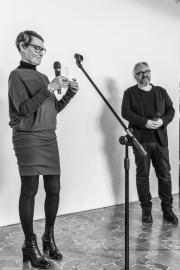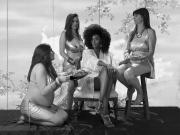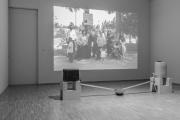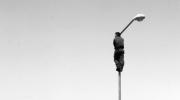Shared history?
The exhibition "Aesthetics and Bias", showed from April through May 2018 at Municipal Gallery Arsenał in Poznań, was a culmination of an academic project initiated by the Israeli artist and performer Adina Bar-On. First conceived in 2008 as part of the Israel-Poland Relations Year, it has begun in 2012 and was presented in 2018. The project was a collaboration between Bezalel Academy of Arts and Design, Jerusalem and four major art institutions in Poland – Academy of Fine Arts in Warsaw, Academy of Fine Arts in Kraków, Academy of Art and Design in Wrocław and University of the Arts in Poznań.
"«Aesthetics and Bias» was a project for art students of various backgrounds who wished to generate art and artistic encounters and to reflect on the bias, prejudice and myth which are an inseparable part of a culture, and on the common frameworks through which we function, assess, and judge each other and ourselves" – explains Adina Bar-On[1].
One hundred twenty students divided into six groups of 20 people each participated in this project. All groups took part in two meetings – one in Israel and one in Poland. During those visits, interdisciplinary workshops took place at specific landmarks, organised to stimulate students' thought, expression, and art. Chosen were the sites imbued with historical, aesthetic and political meaning for both groups. In Israel, it was a hill overlooking the Palestinian village of Issawiya, and a panoramic view of the old city of Jerusalem. In Poland, workshops took place at the foot of the statue of Jesus in Świebodzin, and in the historic Jewish synagogue in Poznań, turned into a public swimming pool during the World War II, kept as one even after the war. "This shared experience of travelling in one's home country and a foreign one, the chance to see one's own reality through another's eyes, and the ability to turn a critical and analytical gaze on all that has been habituated and normalized as a staple of daily life were all crucial pieces of the project" [2].
The inspiring aspect of those meetings was how they stimulated students' art-making in ways different than they encountered before. "Another crucial aspect of the project was that the students were compelled to produce artwork; the eighth and ninth day of each of the 10-day meetings was dedicated to presentations, which required that the students gather their materials throughout the project. Although formal times for personal work were scheduled, students had to stay in «work mode» at all times. The presentation formats included short, digitally restored and lightly edited videos, hand sketches, verbal drafts, sound recordings, or photographed images. It was not an easy task for the students to maintain a creative focus while immersed in the dynamics of travelling, sightseeing, and social intrusions; nothing could be more different from the quiet, contemplative mode if their private studios" – notes Adina Bar-On [3].
One would expect that sharing their respective perspectives and insights would be an excellent opportunity for participants to make the relations between Israel and Poland subject of their works. Eli Petel observed something different. "[M]ost students preferred to avoid the subject and engage with relatively peripheral historical narratives and issues related to ethnic and gender identities and sexual orientation" [4]. The exhibition "Aesthetics and Bias" at Municipal Gallery Arsenał in Poznań included only one-fifth of the works created throughout the project. The project's curators chose the selected pieces that most vividly conveyed the creative experience. The selection included performances, installations, objects, films and photographs.
Marek Wasilewski stresses that the exhibition "[…] confronts its participants and audience with crucial questions about the biases we must overcome in the process of creating art, for art reckons with issues of identity, history and the political. The exhibition reveals how convenient it is to fall back on stereotypes when describing anything that might pose a threat or challenge to the artist" [5].
As Wasilewski reminds: "For young Israelis, to travel to Poland is to return to a land where their loved ones once died" [6]. Shir Cohen prepared "Three Plays about Auschwitz" (2017) in the form of an art book containing text and digital prints of ink drawings. Each of the elements, a classical piece by either Wolfgang Amadeus Mozart or Franz Schubert, initially light in tone, is reworked to discuss the Jewish Holocaust, statistics around it, and its relation to high Western art. It is achieved by editing the works' original lyrics and adding stage directions. The accompanying drawings are images taken from a vocational school hairdressing textbook. They play with a tension between "low" status of hairdressing craft and visual connotations of shaving one's head accompanied by diagrams of the head which are linked to the aesthetics of Nazi Germany.
Eyas Chirurg made the video "So I Go, Pondering and Thinking" (2015) in memory of his grandmother Riva Citrin-Chirurg. She was born in Poland, survived Auschwitz and Stutthof camps, and immigrated to Israel. "When my family and I would visit my grandmother on Fridays, before Shabbat, we would sit together and sing the old Shabbat melodies that she used to sing with her parents, back home. Years have gone by since then, and my grandmother has been betrayed by her own body and mind. But when we sang those melodies together, her despairing hollow eyes would light up, and her spirit would return. These were short moments of grace that would last until we finished singing – and then it was gone" [7].
Kim Gazit talks about her video "Edut" (2014). "During the «Aesthetics and Bias» project, I came upon two testimonies of two Jewish men – one European and the other North African. Both testimonies, a video and a poem, describe grief after the loss of a father during the Holocaust. Despite their differences and distance, I felt the two experiences converged on an almost identical moment of pain. With this in mind, I merged the two testimonies into one piece, one testimony. Krzysztof, a Polish participant in the project, lived in Manchester, England during the same years as I did. This affected both of our English accents. Once again, I encountered the echoes of a parallel experience. In «Edut», Krzysztof's voice recites the new, merged testimony, while I try to synchronise my own voice with his. The subtitles in the video are composed, visually, as an additional active medium" [8].
Camea Smith's "Untitled" (2016) was inspired by two visual experiences she had during her visit to Warsaw. "The first was the scarred floor of the Jewish Historical Institute, formerly the library of the Great Synagogue, torched in 1943 by the Nazis. Traces of the fire are visible on the floor of the main hall to this day: a deformed surface bearing the sings of violent flames. In the building where I lived in Jerusalem, I found a photographed mirror image of that floor: a burnt floor indicating the aftermath of a domestic accident that had left angry scars on the floor tiles. The second experience occurred while viewing a video exhibited in Poland, at the Museum of the History of Polish Jews. The video shows silhouettes of human figures partly hidden behind the array of dots. The thin layer, separating the people from the foreground, resonated with my feeling of great emotional distance from the horrors of the past lurking everywhere in Warsaw" [9].
As Wasilewski describes, "For young Poles to go to Israel is to collide with the exotic Near East and the tension of a country engaged in perpetual military conflict" [10]. Magdalena Morawik's work "Control" (2017) is an object – a gate in a straightforward and elegant form. The visitors had the freedom to pass through it at the exhibition. "Control points at the intersection of two opposing zones to divide freedom from prohibition, and a dangerous situation from a safe one. They are symbolic tools of control, objects that trigger self-control in their users within coded social and cultural patterns. When the control point can be accessed on both ends, it erases the awareness of the zone where the person is in the present moment and thus dilutes the borderlines, making two ambivalent areas co-dependent" [11].
Mikołaj Podworny made his video "Very Nice View" (2014) on "(..) Mount Scopus in Jerusalem. The site offers a magnificent vista of the city. From the summit, we can see the so-called Separation Wall between Palestinian Autonomy and Jewish settlements. The wall features a few dozen gates guarded by Israeli soldiers" [12].
„Aesthetics and Bias”
Municipal Gallery Arsenał in Poznań
curators: Adina Bar-On, Marek Wasilewski
7.04 – 6.05 2018
[1] A Bar-on, "Between Education and Art: About Aesthetics and Bias – Polish-Israeli Art Students Meeting", [in:] "Estetyka i uprzedzenia. Aesthetics and Bias", eds. A. Bar-On, M. Wasilewski, Poznań 2020, pp. 96-97.
[2] M. Wasilewski, "The Aesthetics and Bias and the Bias of Aesthetics", [in:] op.cit., pg. 101.
[3] Ibidem, pg. 98.
[4] E. Petel, "Aesthetics and Bias – Introduction", [in:] op.cit., pg. 92.
[5] M. Wasilewski, op.cit., pg. 101.
[6] Ibidem.
[7] "Estetyka i uprzedzenia. Aesthetics and Bias", pg. 174.
[8] Ibidem, pg. 182.
[9] Ibidem, pg. 204.
[10] M. Wasilewski, op.cit., pg. 101.
[11] "Estetyka i uprzedzenia. Aesthetics and Bias", pg. 190.
[12] Ibidem, pg. 198.




